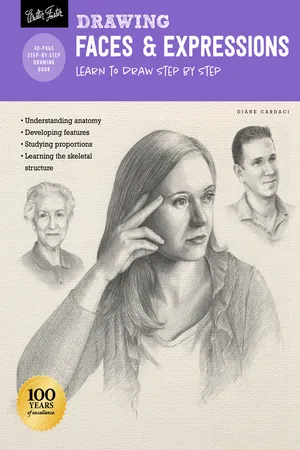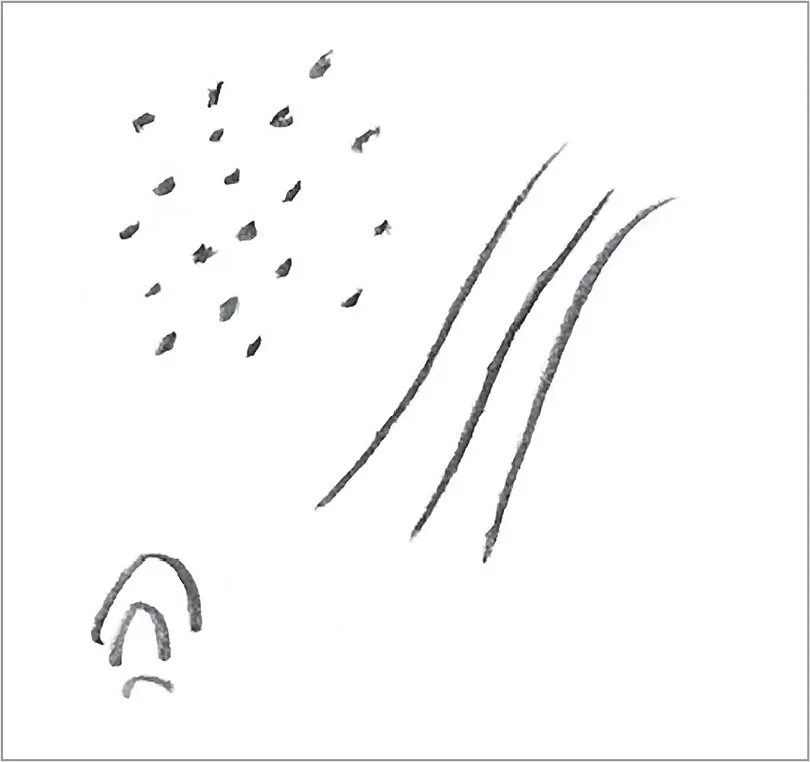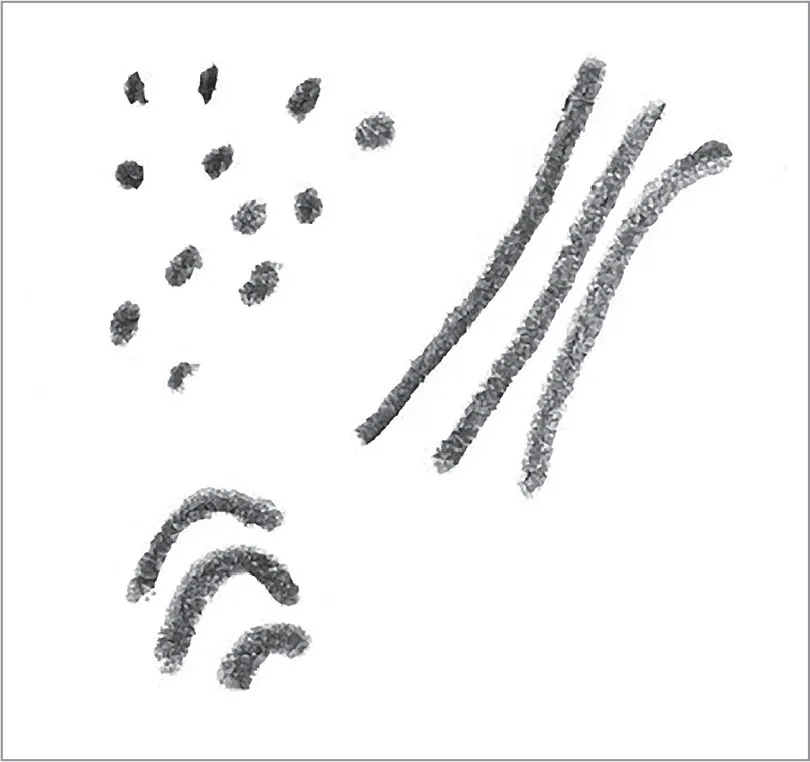
- 40 pages
- English
- ePUB (mobile friendly)
- Available on iOS & Android
eBook - ePub
About this book
With Drawing: Faces & Expressions, learn to draw detailed, realistic human faces in graphite pencil from basic shapes.
Perfect for beginning artists, Faces & Expressions offers a comprehensive introduction on how to draw faces and expressions—the most important aspects of an individual. First, learn everything about the tools and materials you need to get started, including selecting the right pencils, papers, and erasers for their work. Then discover tips for drawing and shading techniques, such as how to achieve volume, suggest depth, and render various hair and skin textures. With some knowledge of pencil drawing basics, begin mastering the art of drawing the human face through a series of helpful examples and easy-to-follow, step-by-step projects. Projects include a child portrait, an adult portrait, a senior portrait, and others that feature different techniques for capturing expressions and rendering features, including eyes, mouths, noses, and hands.
Featuring the stunning artwork of gifted artist Diane Cardaci, this 10.25 × 13.75–inch book features artwork designed to inspire a classical approach to rendering faces in graphite pencil. With its wide-ranging instruction, plethora of artist tips, and beautiful artwork, Faces & Expressions is the perfect resource for any beginning portrait artist.
Designed for beginners, the How to Draw & Paint series offers easy-to-follow guides that introduce artists to basic tools and materials and include simple step-by-step lessons for a variety of projects suitable for the aspiring artist. Drawing: Faces & Expressions allows artists to develop drawing skills by demonstrating how to start with basic shapes and use pencil and shading techniques to create varied textures, values, and details for a realistic, completed portrait drawing.
Perfect for beginning artists, Faces & Expressions offers a comprehensive introduction on how to draw faces and expressions—the most important aspects of an individual. First, learn everything about the tools and materials you need to get started, including selecting the right pencils, papers, and erasers for their work. Then discover tips for drawing and shading techniques, such as how to achieve volume, suggest depth, and render various hair and skin textures. With some knowledge of pencil drawing basics, begin mastering the art of drawing the human face through a series of helpful examples and easy-to-follow, step-by-step projects. Projects include a child portrait, an adult portrait, a senior portrait, and others that feature different techniques for capturing expressions and rendering features, including eyes, mouths, noses, and hands.
Featuring the stunning artwork of gifted artist Diane Cardaci, this 10.25 × 13.75–inch book features artwork designed to inspire a classical approach to rendering faces in graphite pencil. With its wide-ranging instruction, plethora of artist tips, and beautiful artwork, Faces & Expressions is the perfect resource for any beginning portrait artist.
Designed for beginners, the How to Draw & Paint series offers easy-to-follow guides that introduce artists to basic tools and materials and include simple step-by-step lessons for a variety of projects suitable for the aspiring artist. Drawing: Faces & Expressions allows artists to develop drawing skills by demonstrating how to start with basic shapes and use pencil and shading techniques to create varied textures, values, and details for a realistic, completed portrait drawing.
Frequently asked questions
Yes, you can cancel anytime from the Subscription tab in your account settings on the Perlego website. Your subscription will stay active until the end of your current billing period. Learn how to cancel your subscription.
At the moment all of our mobile-responsive ePub books are available to download via the app. Most of our PDFs are also available to download and we're working on making the final remaining ones downloadable now. Learn more here.
Perlego offers two plans: Essential and Complete
- Essential is ideal for learners and professionals who enjoy exploring a wide range of subjects. Access the Essential Library with 800,000+ trusted titles and best-sellers across business, personal growth, and the humanities. Includes unlimited reading time and Standard Read Aloud voice.
- Complete: Perfect for advanced learners and researchers needing full, unrestricted access. Unlock 1.4M+ books across hundreds of subjects, including academic and specialized titles. The Complete Plan also includes advanced features like Premium Read Aloud and Research Assistant.
We are an online textbook subscription service, where you can get access to an entire online library for less than the price of a single book per month. With over 1 million books across 1000+ topics, we’ve got you covered! Learn more here.
Look out for the read-aloud symbol on your next book to see if you can listen to it. The read-aloud tool reads text aloud for you, highlighting the text as it is being read. You can pause it, speed it up and slow it down. Learn more here.
Yes! You can use the Perlego app on both iOS or Android devices to read anytime, anywhere — even offline. Perfect for commutes or when you’re on the go.
Please note we cannot support devices running on iOS 13 and Android 7 or earlier. Learn more about using the app.
Please note we cannot support devices running on iOS 13 and Android 7 or earlier. Learn more about using the app.
Yes, you can access Drawing: Faces & Expressions by Diane Cardaci in PDF and/or ePUB format, as well as other popular books in Arte & Técnicas artísticas. We have over one million books available in our catalogue for you to explore.
Information
TOOLS & MATERIALS
The first step for any drawing project is to gather the necessary tools and materials. Deciding which tools to use depends on your subject and which materials you are most comfortable using. The tools and materials detailed here will help you get started.
PENCILS
Intricate or detailed drawings call for harder leads, or H pencils. Hard pencils are labeled 9H to H, with the highest number being the hardest. Soft pencils run from B to 9B, with 9B being the softest. Soft pencils create much darker lines and velvety tones. You can also choose graphite lead holders that come in different diameters, or woodless pencils, which have the advantage of a larger diameter lead.

PENCIL STROKES
On the sample shown here, I used a 5H pencil, which has a hard lead. On the sample below, I used a 6B pencil, which has a much softer lead. You can see how the strokes of the 5H pencil are much sharper.


SHARPENERS
If you choose a traditional pencil, you will also need a sharpener. You can use a small, handheld sharpener or an electric sharpener. To sharpen lead in a lead holder, you will need a specialized sharpener called a “pointer.” Flat sketching pencils can be chiseled on a sandpaper pad.

ERASERS
My favorite eraser is the kneaded eraser, which can be molded to give you a lot of control over what you want to erase. There are also vinyl erasers and electric erasers. It is also very handy to have an erasing shield, which works like a stencil and protects other parts of the drawing.

BLENDING TOOLS
There are several tools that can be used to smudge and blend graphite. A blending stump is made of paper and has two pointed ends that can be used for blending. A tortillon is similar, but is hollow and has only one point. When you’re working with a larger area, you can use a chamois cloth for blending.

PAPER
The quality of your paper directly influences the appearance of your artwork. Paper is often categorized by its “tooth,” or surface texture. The paper’s tooth affects the smoothness of your drawing and the number of graphite layers you can apply before the paper rips. Below are the most common surface types:
• Hot-pressed paper has little to no tooth, resulting in smooth textures.
• Cold-pressed paper has more tooth than hot-pressed paper; its grainy surface yields more textured strokes.
• Rough paper features a coarse tooth that creates rough, broken strokes.
I prefer working on Bristol paper—a thick paper that is available in a sm...
Table of contents
- Cover
- Title Page
- Contents
- Tools & Materials
- Drawing Process
- Copyright